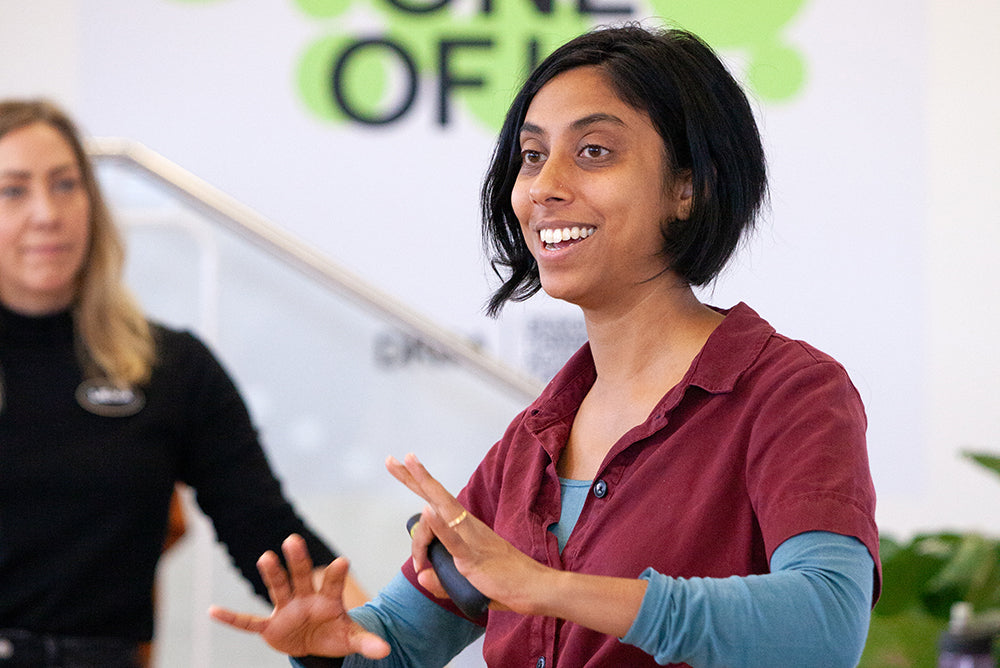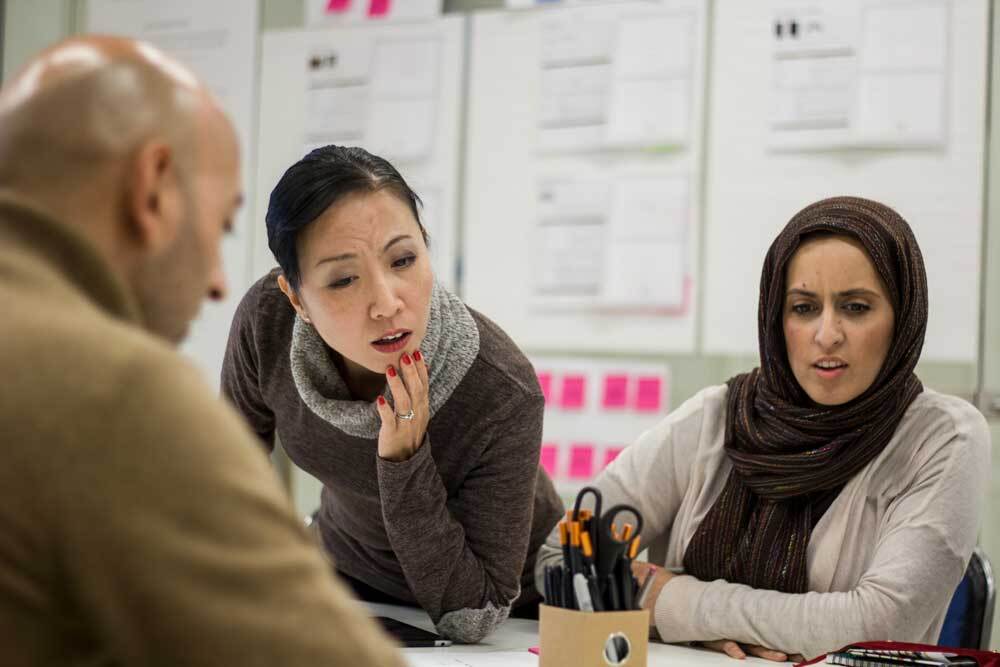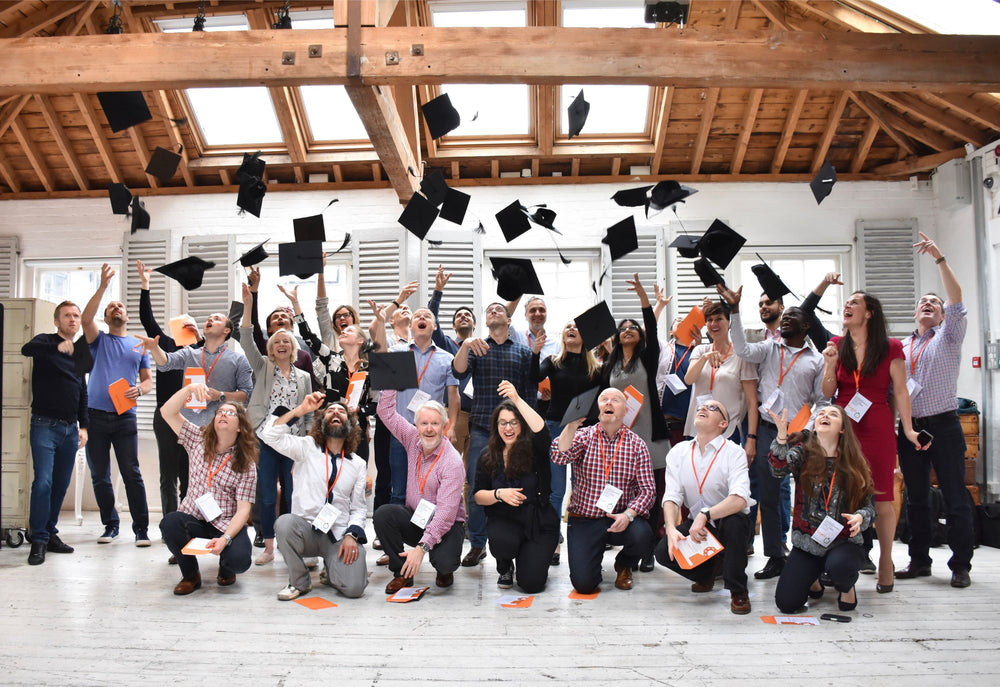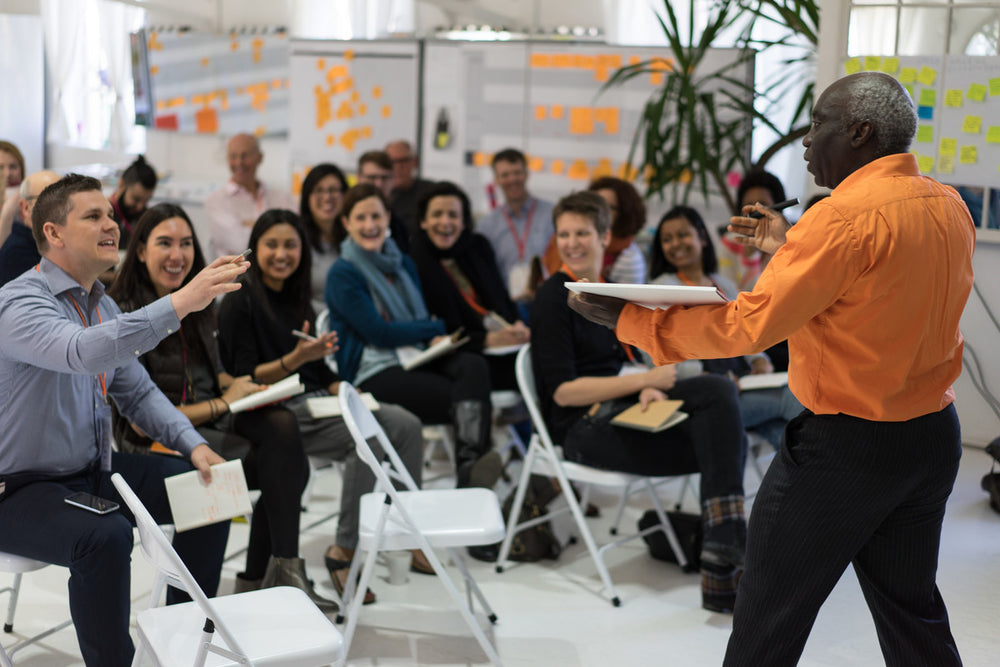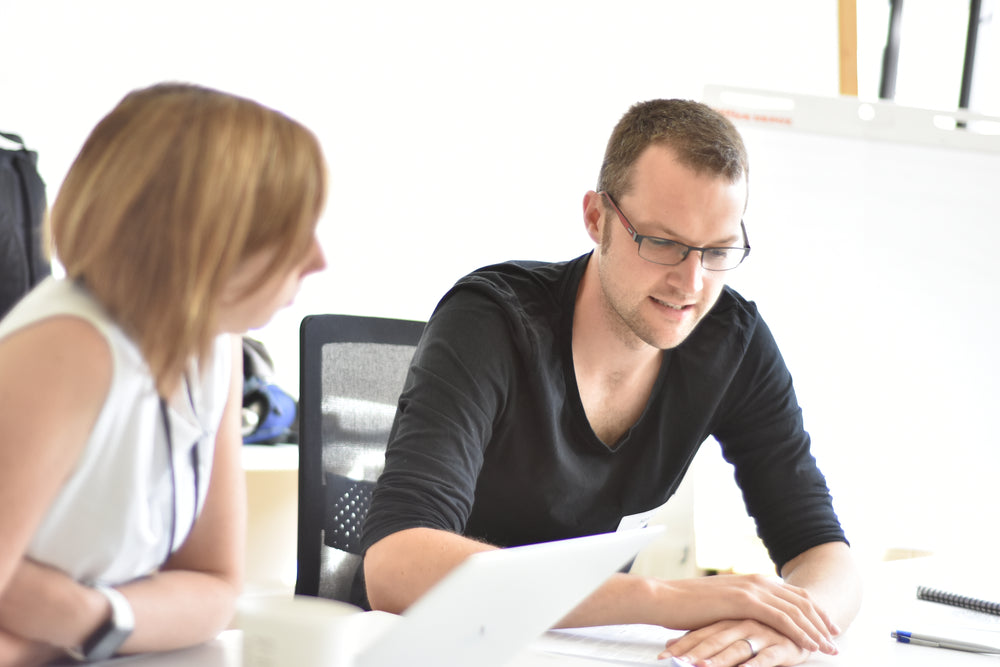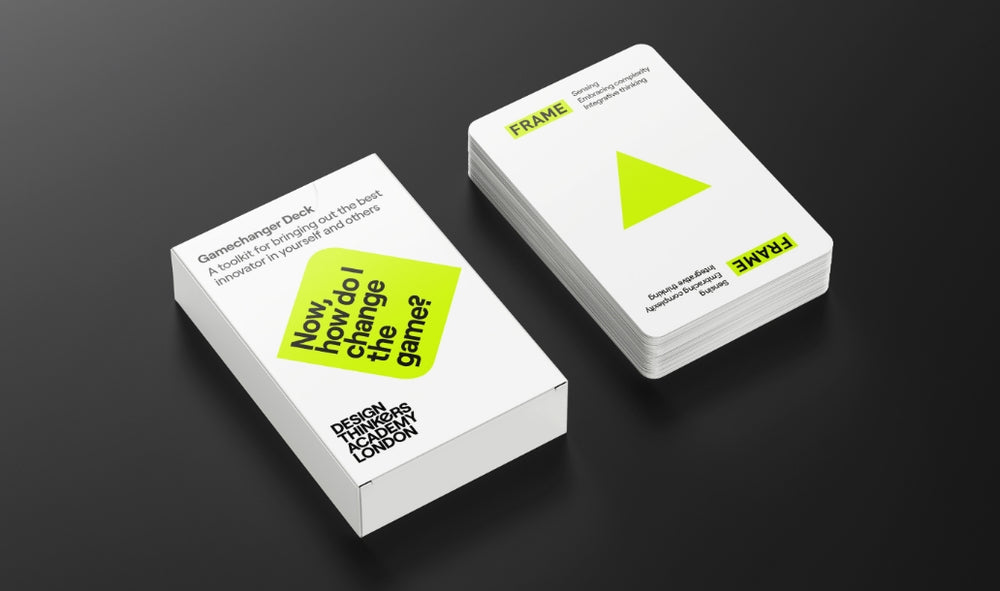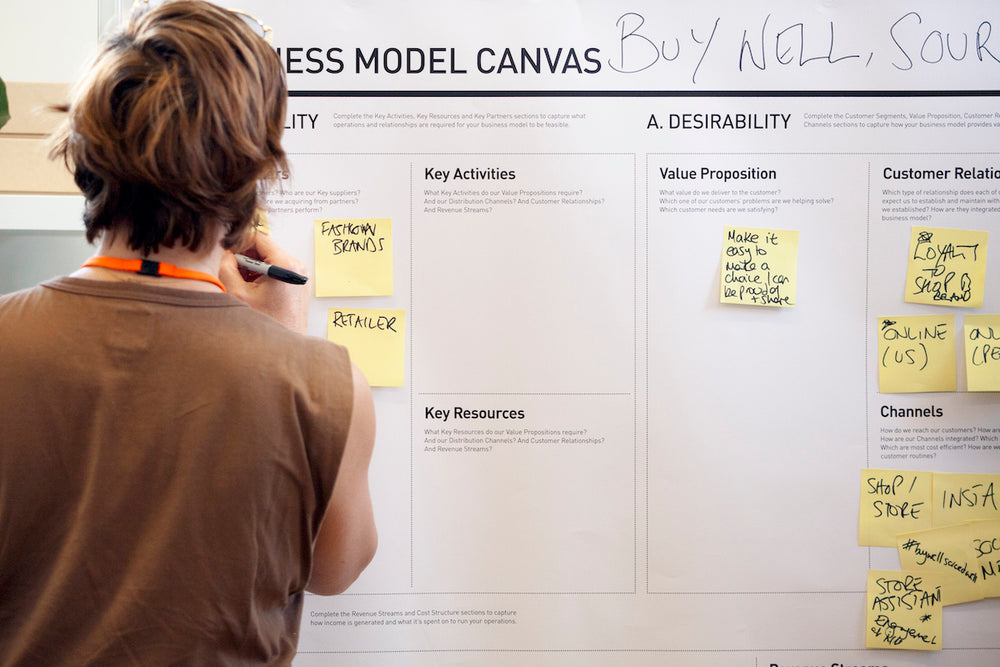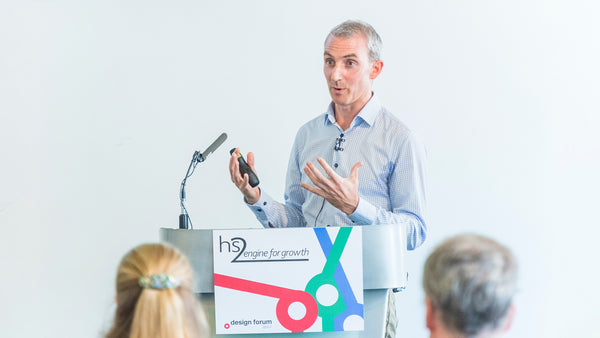Storytelling is not only for creatives. It could be your secret weapon in the office too, from persuading people to go with your idea, to delivering the best presentation of your life.
At our recent Storytellers event held at consultancy Arup’s flagship London office, individuals from the world of engineering (Arup vice-chair Tristram Carfrae) and architecture (Sadie Morgan who co-founded the DRMM practice) joined those from advertising (creative director, Ray Shaughnessy) and filmmaking (Peter Ettedgui has created films and documentaries).
We’ve taken the best tips, advice and stories from the event and shared them below. These nuggets have helped win arguments, contracts, and even prizes. You can watch the video below to hear the tips in-person or follow them in the blog below. And if you want to sharpen your storytelling skills, and learn even more techniques, why not sign up to our one-day Storytelling course on July 14th?
-
Look for the conflict in the story you want to tell:
Peter Ettedgui (Filmmaker): Every single story that I'm telling, within a traditional story space, hinges to some degree on conflict. You have to engineer that conflict and then you have to engineer your way out of it. A dramatist explained storytelling very simply: you get your hero up into a tree - that's act one. Act two is you throw rocks at them, and act three is you help them to get back down! So, I think there's a great deal of conflict resolution in the process of actually telling a story.
-
A story must contain core truths
Ray Shaughnessy (Advertising Creative Director): For us, as advertising creatives, we're sometimes just given the fact, and who just wants a fact?! We need a story to be able to entertain, to be able to pull people in. But we have a truth at the heart of everything that we do. That's what makes the best work.

Example: Using core truths:
Ray Shaughnessy: We had this really tricky brief, which was, "How do you sell butter to diverging food markets?” So you're talking about places like Germany, as well as places like Dubai. How do you talk about butter?!
This is a process where we go really far and wide. So we start thinking about all the associations to do with this moment of creation. And we realised that there was this moment within cooking where you are standing at the oven. There is this moment of alchemy: that is really interesting. It’s like a witch in her space at a cauldron, ready to conjure up some magic.
I had also read this book which was about a very dysfunctional family. It had this woman who had many, many problems and the only moment that she gets respect is on a Friday night when she's cooking and people come past her window. And she said, "That is when people want a piece of me," and we were like, "Well, that is just fascinating!" So we translated the universality of that into a film. And it did transcend all of the food cultures around the world and was a very successful piece of work.
-
A story must evoke emotion
Peter Ettedgui: I always think of a movie, whether it's fiction or nonfiction, as being something like an empathy machine, because you are taken out of yourself and you identify with someone who is utterly different from yourself, up on the screen. You’re taken on a journey by them. And it's a journey that will give you a sequence of emotions and feelings that are very different perhaps to the ones that you'll experience in your everyday life. And when you've watched the story, often about transformation and change, you are, in some ways, subtly changed and transformed by that experience.

Example: Emotion trumps being clever
Tristram Carfrae (Engineer): I'd only been in Arup about five years and I was working for an engineer called Peter Rice, a wonderful storyteller, and I remember I was scribbling away – I think it was working on the Pavilion of the Future in Barcelona and trying to come up with something really clever. I remember Peter looking over my shoulder and saying: "Tristram, it doesn't matter how clever your structure is, the only thing that matters is how you make people feel when they experience it." I've never forgotten that. In other words, that engineering is only a part of creating something for people to experience.
Example: Putting feeling in action
Ray Shaughnessy: Sometimes when all we’ve got is 60 seconds, or sometimes 30, or eight words on the poster, then we need to make you feel something. We need an emotional attachment to something. When F1 came to the Wieden+Kennedy agency, ahead of the 2018 season, we rebranded them to make them future-fit. They had never done a brand campaign before.
When we're thinking about a sport that's going to be played out, trying to get new fans in 40 different countries, we need to tap into a feeling. So the thing that we got excited about was this very visceral mix of engineering. So the campaign that launched the season was called "Engineered Insanity." But the bit that I was interested in, as someone who wasn't interested in sport at all, was this kind of blood and oil. There's a kind of humanity there with this engineering. As my creative partner Dan would tell me excitedly, "All you want to do is get in the cockpit!" So, we took fans, and we put them in a wind tunnel and subjected them to that literal kind of feeling.
-
Pick the right story to win the work

Tristram Carfrae: This is a story of a bridge in Singapore. Cox Architects and Arup were appointed as architects and engineers. We came up with the concept you see here, top left, and we took it to Singapore and presented to our client, the Urban Regeneration Authority. In our presentation, Philip Cox said, "You know, that it's reminiscent of a Malaysian fish trap," trying to get a cultural reference in as part of the story, the narrative. At the end of the presentation, Mrs. Koh, the director of the URA, looked at us very sternly and said, "So Professor Cox, Professor Carfrae, why do you think Singaporeans want to be treated like fish? And should they indeed be fish, why would they want to be caught in your bridge? " We were just demolished. It was a fail for us!
We went back to Australia and started thinking again. We looked at the image on the top left and said: "What is it that we like about this? Which are the characteristics of this bridge that are good, and which bits are bad?" We decided that the elements that spiral away along the tube were actually the interesting bits. One spiral isn't really a structure though - it's like a slinky toy, it just droops between two points. But I thought maybe two spirals in opposition to each other, and in different diameters, could be configured to be a structure. So we came up with the design in the top right. But the punch line is that we went back to the URA and said: "we have a bridge that represents DNA, that represents life sciences, biotech, the future of Singapore.” Ta da! The design was commissioned!
-
A story can transform the ordinary into a prize-winner

Sadie Morgan (Architect): Hastings Pier is an amazing story. It was a community-led project, funded by the community. So, we literally had an extraordinary influx of opportunity for the community to tell us what they wanted. In the end, we had a thousand different ideas. And then we sort of thought: "do you know what, we can't make anything that will please everybody! In fact, the only thing that will please everybody is to do nothing at all and to leave it open for the community to use it as they see fit."
So, we just serviced it really well and made sure that it had everything in order so that it could be a playground. You could have a rock concert there. You could kind of do anything.
Originally for us architects, it was our dream project. It was like: "my God, we're going to put this incredible building at the end of the pier!" and then we realised very quickly that that wasn't necessarily the right outcome. And the outcome was actually just to make a service deck that could do anything. So we had to hold back on our architectural ambition.
When the pier was shortlisted (this was our third attempt at winning the Sterling Prize for Architecture), we really thought about how do we tell the story of a ‘non-building’ to a set of architectural critics? In the end we just told the story of our nine years of involvement, the ways in which the community had come together, the ways in which the project had evolved. I always think when you do go to Hastings pier it has the spirit of the energy, the love, the commitment of everybody. And I think the story really went a long way to convincing the judges that it was the right project, at the time, to win. And... ever since then, I say “tell the story!".
Whenever we talk about projects, it's so important not to describe what's in front of you, because architects are like: "we picked the blue and look at the window detailing!"
It’s so important to bring in the perspective of how, why: what is it about your practice that has made this a special project?
-
A project can have different stories for different audiences
Background: Antoni Gaudí’s La Sagrada Familia church, in Barcelona, is finally due for completion in 2026, one hundred years after his death. In 2014, with the building 60% complete, the Sagrada Familia Foundation approached Arup to help with the remaining structural design, particularly how to produce the remaining six towers.
Tristram Carfrae: On the Sagrada Familia church project, there are so many different stories here that it's really hard to decide which stories are the important ones. Here we have one of the geniuses of the last century, Antoni Gaudi, trying to enact his intent long after he died, after his all his drawings and models were blown up in the Spanish Civil War.
The first piece we helped design was the Mary Tower, which sits right at the front. So it's the first of the six big towers on top of the structure. It changed Barcelona's skyline, in terms of Sagrada, for the first time since 1926. They continued to construct the Mary Tower during the COVID pandemic, and it got completed for Christmas 2021.

We sped up construction by a factor of ten. We did this by combining offsite prefabrication of large components and then on-site assembly of those components. It's partly because of this approach, that construction becomes an act of theatre and a ballet – big pieces being picked up and put down with very few people. No noise, no disruption. Construction as a benefit, not as a blight. However, the big story here for me, I think, is that this is the only project I'm aware of which is self-financing. The cost of the construction of this amazing church is purely financed by people coming to watch it being built. Just think about that and what we could do in the world of building and construction with that concept!
-
The right story can turn an enemy into a friend
Sadie Morgan: I remember when I first met former Government minister Lord Heseltine. I was brought up in a commune and I used to throw darts at a picture of him as a kid! So I said: "Lord H. I used to throw darts at you." He said: "well my dear!" And we were instantly friends!
You may not do it in every situation, but I think you can tell a story in a way that bonds you to somebody.
-
A story can influence decisions
Tristram Carfrae: When we first joined the Sagrada project, the method of construction being used was to make things in concrete and then clad them with stone to make something that was reliable structurally and then to make it look like stone. However, we were very keen to use post tensioned stone. This is big stone blocks pulled together with steel rods to effectively get the same result. There was a lot of disagreement. And I've been told that we persuaded people with a story that I made up on the spot, which was that: “why take a piece of stone and hollow it out and fill it full of messy stuff that you've just made rather than using the whole piece of stone in the first place as it comes out of the quarry?!”
-
A shared story can keep a team on track
Peter Ettedgui: We're having an enormous amount of conflict on the story that we're currently putting together. And, making sure that everybody is on the same page, quite literally in the case of this story, that everyone understands the story that you're trying to tell, is a critical part of the process.
When problems come up, which they do on a daily basis, it’s important that people are finding solutions to those problems based on that common story. What you're collectively trying to do, rather than going off in a different direction, panicked by the latest rock that's being thrown at you.
Biographies:
Peter Ettedgui: Peter is a filmmaker whose documentaries have won him multiple awards on subjects as diverse as the Paralympics (Rising Phoenix), and fashion (McQueen). Peter’s new series for HBO/Sky, Kingdom of Dreams, on the fashion industry, launches later in 2022.
Sadie Morgan: Sadie is founding Director of Stirling Prize-winning architecture practice, DRMM. Their work includes ground-breaking projects in housing and sustainability. Sadie is a leading voice on our national infrastructure and is Chair of the HS2 Independent Design Panel.
Tristram Carfrae: Tristram is Deputy Chair of Arup and holder of the Gold Medal from the Institution of Structural Engineers. Tristram is a champion of digital fabrication in structural engineering. He is using this to help complete the design of Antoni Gaudi’s Sagrada Familia.
Ray Shaughnessy: Ray is one of London’s top Creative Directors. She has helped reimagine the brand narratives of household names such as Formula 1, Lurpak butter and Sainbury’s. She has led creative output for major agencies, such as McCann and Wieden+Kennedy.
